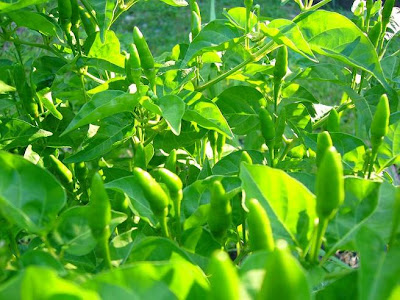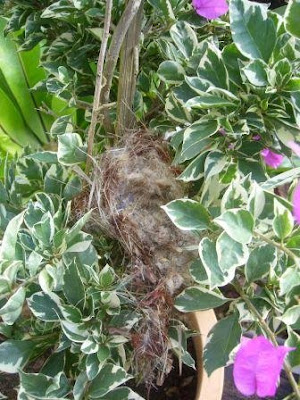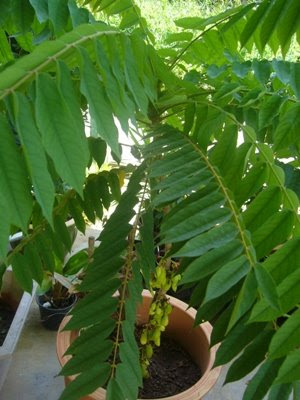Hope it's not too late to wish each & every mom out there a 'Wonderful Mother's Day'
It has been quite a while since my last post to this blog, been really busy with everyday errands. The weather in this beautiful country is fast climbing up the scale, with the highest average recorded temperature for the whole of last week being 33deg celcius.
Every year, the month of May is the most memorable month for me..firstly being my birthday falls on this month, it also a month where a special 1st Sunday will be a tribute to all mothers.
As a tribute to all mothers out there who visited this blog, young or old & wherever you are...I've compiled part of my collection of pictures of my special blooms throughout my gardening passion for your viewing pleasure. Have a wonderful Mother's Day today with your loved ones. Sit back & do enjoy the slideshow.
A special tribute to all the special moms out there, young or old...this is for you coz you're special & unique as these blooms.....
Sunday, May 10, 2009
Happy Mother's Day!
Monday, April 13, 2009
Herbs anyone??? (Part 6) - Bird's Eye Chilli
Being labeled as one of the most spicy member of the Capsicum plant genus, the Bird's Eye Chilli is categorised under the hot chill pepper group. The Bird's Eye Chilli is also known in Malay as Cili Padi or Cili Padi Kampong and is related to many other types of chillies that can be found in the region.
Eventhough, there are many types of chillies that can be found all over the world, one common characteristics that can be found in every species is the chemical constituent known as capsaicin. These chemical capsaicin actually is the one responsible for the stimulation of the nerves in the mouth, facial parts like nose, mouth & eyes that causes burning sensation.
Chilli peppers of all types are rich in vitamin C, K and carotenoids, where the vitamin K helps in blood clotting. Chillies of all varieties are known to contain antioxidant properties, therefore, they prevent cell damage and act as anti-aging agents..so you gals & guys out there...don't need any expensive vitamins or expensive creams..just increase the chillies in your everyday diet to stay young ;-)
Some findings also revealed that one of the ingredients that exists in the chillies helps to control insulin levels and lowers blood glucose levels. The natural capsaicin presence in the chillies helps to burn calories and with regular consumption of the fruits actually helps in reducing weight..uummhhh, that will be a good excuse for wanting to eat more chillies :lol:
The capsaicin also helps in protecting from prostate cancer and has long been used as a topical ointment for relieving pain. This probably acts as counter irritant, ie. when the nerves are stimulated, we will forget the actual pain. It is also believed to relieve inflammation in athritis.
Another interesting findings of the health benefits of the chillies is that it help in relieving the nasal spasm, clear runny nose and free the nasal passage..uummh, why didn't I think of that when I was having a bad flu last month???


Presently, I have two matured Bird's Eye Chilli shrubs in my garden, one is planted in a 9 inch pot and placed under shade whereas the other shrub is planted out in the open, alongside with my lemongrass & citronella plants. Both shrubs produced lots of fruits but the distinct difference is in the colour of their leaves. The shrub that was planted out in the open under bright, sunny sunshine everyday, produces light-green coloured leaves whereas the pot that was placed under shade have much deeper-coloured dark green leaves..as for the level of spiciness, both are out of the scale of 10...really,really firing HOT!! phew!
With all the good benefits from chilli peppers, it is highly recommended that we include them in our daily diet...either the sweet chilli peppers or the hot,spicy ones..the choice is yours :)
Tuesday, April 7, 2009
Another new home??
Few days ago, while browsing through my potted plants especially those tall shrubs..I noticed there's a new bird nest in the making. Other than the swift that have been sharing our home for almost two years now, this new resident bird home is totally not related to the former.
Firstly, the nest are totally made of dried grasses and twigs and secondly, it is located in between the branches of my slightly tall Dracaena Surculosa var Punculata (commonly known in Malay as Pokok Buluh Jepun, indirectly translated as the Japanese Bamboo). Till now, I have not seen the owner of the nest..could be it has been abandoned for various reasons.

I also discovered another possible 'home', which is stuck in between my blooming purple bougainvillea shrub.
Last but not least, the tenants that have been sharing the corner of my home for almost two years..increasingly by the day..jpg)
.jpg)
.jpg)
Friday, March 27, 2009
Hooray!! Another successful kitchen blooms....
After the success of my kitchen blooms ie. the pink gloxinia late last December 2008/early January 2009,I was really overwhelmed with another successful experiment.
From this piece of leaf propagation last year....
To this elegant beauty just a few days ago....

Another successful plant placed at my kitchen window's sill is the 'Tiger Stripe' Episcia. From this initial plant given by a friend (Thanks Kak Mona)...
To really healthy plant that successfully produced a second bloom almost the same time as the purple gloxinia.

All plants & plantlets gracing my kitchen window's sill receive at least 2 to 3 hours of morning sunshine daily (provided it is not a cloudy or rainy mornings) and a few dose of diluted liquid fertiliser to enhance as well as to boost their growth & health.
For my successful gloxinias & episcia, I thank my forum friend who shared the same interests, who gratefully gave me the plantlets & leaf cuttings for the successful propagation. Thanks once again Kak Mona ;-))
Friday, March 20, 2009
Now, you see it & Now, you don't.......
It's not the famous chocolate chip cookies commercial that we often see on television, it's not even related to any food products whatsoever.
Recently, while pruning & fertilising my potted garden, I noticed two very unusual, beautiful insects hiding & camouflaging themselves in between the foliage. The beauty of the designs on their wings are so very unique & beautiful. For once, I was quite stunned with admiration with the beauty of Allah's creation. Enjoy the beauties:



Saturday, February 28, 2009
The Sun, the Heat & the Blooms...
After a period of cool, heavy rainfall for almost a month which indirectly affected many residents' homes & geological structure of certain areas in this country..the humid hot weather are here again.
To welcome the bright sunshine almost every morning in my potted garden, is a basin of the sun-loving Water Hyacinth (locally known as Keladi Bunting in Malay) with its beautiful non-lasting light lavender blooms. Thou its blooms are non-lasting ie. it lasted only for a day but with rich medium (water & fertiliser) and direct sunlight, it is a fast grower & a regular bloomer.


Tuesday, January 20, 2009
Kitchen Blossoms...
First & foremost, a belated salam Maal Hijrah 1430 to all my muslim friends & readers and not forgetting to wish all my blog's visitors a very belated 'Happy New Year 2009'. December 2008 had been quite a hectic, tiring but an enjoying month for myself and family, welcoming some of the family members who came here for a visit. Residing in a country away from our family & loved ones tend to make us miss their presence especially during family gatherings. Thus, having family guests & friends visiting us to our humble home here is such a joy.
My first baby Gloxinia given by a forum friend (thanks to Kak Mona) has matured & finally presented me with a pair of beautiful pink blooms. The gloxinia plant as well as other plants have been gracing the kitchen's window sill to enjoy the daily morning sun since October last year.

Previously, the gloxinia together with my other plants was placed in the living room but due to lack of sunlight, they wasn't growing very well. Approximately about 2 weeks after placing the tiny pots by the kitchen's window sill, the plants seemed to enjoy their new environment by producing healthy leaves with favourable size. I noticed the gloxinia's first flower bud sometimes early December last year and precisely on the 29th December 2008, it bloomed..sort of welcoming the Hijrah New Year 1430. Around a week later, the other flower bud followed suit, fully bloom to a size of approximate 3.5cm in diameter in bright pink..thus welcoming the New Year 2009. It's really an achievement for myself to be able to nurture such a plant from a tiny baby till it matures and producing beautiful blooms..sort of an encouragement to increase my collection with different other species.


What a glorious, beautiful way to welcome the new year..
Tuesday, November 11, 2008
Herbs anyone??? (Part 5) - Aromatic Ginger
The Kaempferia Galanga Linn is also known as the Aromatic Ginger, Sand Ginger a, Pokok Cekur (Malay) or Kencur (Indonesian). The plant can be found primarily in open areas in southern China, Taiwan, Cambodia and India, but is also widely cultivated throughout Southeast Asia. The plant as a whole is used as a herb for cooking in Indonesia especially the rhizome whereas the aromatic leaves are sometimes used in some of the Malay cuisine and whereas, the young leaves are even eaten raw as salad or ulam. It is believed that by doing so, it helps to remove unwanted 'wind' from the body and helps to maintain a youthful complexion.....uummmmhh :) To use onto young children especially newborn babies, pound the washed leaves and rub or apply onto their tummy to get rid of the unwanted wind.

The rhizomes of the plant, which contains essential oils, have been used in Chinese medicine as a decoction or powder for treating indigestion, cold, pectoral and abdominal pains, headache and toothache. It is also used in Chinese cooking and medicine and is sold in Chinese groceries under the name "Sha Jiang" or "Sand Ginger."Its alcoholic maceration has also been applied as liniment for rheumatism.Kaempferia galanga has a peppery camphorous taste.
The flowers of the Kaemphferia Galanga Linn consists of a few small, soft white petals with a tinge of dark purple. Propagation is by separating the rhizomes into rich, well-drained medium under indirect sunlight.
Another closed relation of the Kaempheria Galanga Linn is the Kaempheria Pulchra 'Bronze'. The plant is also known as the Peacock Ginger or Pokok Cekur Hitam (Malay). The plant is a fast grower compared with only a small plantlet that I bought a few months ago. The main difference between the Kaempheria Galanga and the Kaempheria Pulchra is the colour of the flowers and the leaves. The leaves of the Kaempheria Pulchra is broader & harder and eventhough the size & texture of the flowers are the similar, the main difference is the colour is purplish with a tinge of white in the middle...a total reversal colour of the flower of the Kaempheria Galanga.
The most obvious problem that I noticed when having Peacock Ginger plants is that the beautiful leaves are prone to attacks by small caterpillars and grasshoppers...a good solution to distract all these tiny insects/creatures is to crush finely a clove of garlic and let boil with a litre of water, let to cool & mix with a small amount of dishwashing liquid. Pour the solution into a water sprayer and spray the affected leaves of the plants, taking note NOT to spray onto the roots.
Tuesday, November 4, 2008
Poison or Cure???
It's been a while since my last post to this blog. With the Eid festivities luncheon & 'open houses' invitations by spouse's friends coupled with the girls' school's examinations, its been a really hectic month of October 2008. Furthermore, with all the activities, I have not been the best of health for the last few weeks...oooohhhh :(
By the way, have you heard of the Angel's Trumpet, Devil's Trumpet, Downy Thorn Apple, Metel? All of the mentioned names referred to the same plant, the Datura Metel var Fastuosa or locally known in Malay as the Pokok Kecubung.
I obtained the seeds of this plant while on holiday in Penang, Malaysia a few years ago while visiting the state's herb garden, mainly attracted by its beautiful white, with a tinge of lavender trumpet-like flowers and unique thorny fruit.
Native to China, India and South-east Asia countries, the Datura Metel is extremely poisonous but surprisingly, the plant is used traditionally in Chinese medicine.

The shrub-like perennial herb/plant consists of ebony black stems, each stem holds a large angular dark-green leaves similar in shape to that of the eggplant leaves. The large tubular flowers normally have a double or triple corolla, with each corolla having a deep purple exterior and white or off-white interior. The scented flowers are hermaphrodite (having both male & female organs) and pollination is usually done by insects. What I noticed about this plant that I have in the container pot, there's lots of ants seems to be attracted not only to the flowers but to the plant as a whole.
The thorny like fruits which holds the seeds are almost rounded, approximately around 2.5cm (1 inch) diameter. Upon ripen, the matured fruits will automatically 'burst' open thus dispersing the seeds.


The dry flower, particularly the violet coloured, if rolled and used like a cigar is believed to relieve the asthma or wheezing-like symptoms but it should only be used under the guidance and supervision of a qualified medical practitioner.
The plant as a whole is extremely toxic if digested in any quantity, symptoms like hallucinations, headaches, flushed skin and possibly convulsions or even coma. Accidentally (or intentionally) indigestion even a single leaf could lead to severe side effects..so strict PRECAUTION should be taken to avoid planting the Datura Metel plants near or households with children, they might just get enchanted & attracted with the beautiful flowers. The best way, is to totally avoid planting this extremely poisonous plant in the garden.
Saturday, September 20, 2008
Can't believe it! It fructify.....
When we came back from our short trip from Kuala Lumpur last August, I noticed some flowers around the tiny stem of the plant. My assumption was, perhaps due to the lack of water (been away for a week), the humid hot weather will actually trigger most plants to produce blooms. After a week, I noticed that the flowers withered and small fruits appeared. I just can't believe it that my Belimbing Buluh tree or should I still consider it a plant is actually bearing normal size fruits. Uummm, it's really unexpected from such a small plant but I will pluck them in no time to add to my sambal, vegetable dalca or acar buah that I'm planning to cook.


Why I still consider it a plant and not a tree?? The height of the plant is not even a metre tall considering it can actually reach to the height of 5 mtrs to 10 mtrs tall upon maturity. Furthermore, I bought the seedling, planted in a black polybag at the local Sunday market around 6 months ago for a mere $3 in local currency.
The Belimbing Buluh is a local favorite plant/tree and is a close relative of the Carambola or popularly known as the Starfruit. Botanically the Belimbing Buluh is known as Averrhoa Bilimbii and it is also known as the Cucumber tree, Blimbling, Tree Sorrel and many other names. Apparently it originated from the Molluccas, Indonesia and the species is mostly cultivated or found semi-wild throughout Indonesia, Phillippines, Sri Lanka, Bangladesh & Myanmar. It is also commonly found in other Southeast Asian countries. It is considered a tropical tree, less resistant to cold if compared to the Carambola (Starfruit).
The plant is considered long-lived, can reach up to the height between 5 mtrs to 10 mtrs tall with the short trunk quickly divided into upright branches. The oblong 11 to 37 leaflets are alternately arranged in a cluster on a long stem about 30cm to 60cm long. The dark-red flowers, appearing in panicles, bloom from the trunk and oldest branches, are small and fragrant and often in great number towards the bottom of the tree. Bright-green fruits follow,5cm to 8cm in length, often in clusters and a single tree often produces hundreds and hundreds of fruits. The fruits of the Belimbii which is very sour compared to the Carambola (Starfruit) are often added onto some of the Malay cuisines such as Sambal dishes, curry dishes & others.

The fruit is traditionally used to help those suffering from high blood pressure and from high fever. For treating high blood pressure sufferers, the fruits are blended, drained to obtain just the juice and drink either in the morning or night. If prefer, sweeteners can be added to the juice since the juice by itself is bitter. The leaves are washed, hand crushed and put onto a piece of cloth which is then put or leave on the forehead to relieve high fever. In some parts of Malaysia the leaves of bilimbi are used as a treatment for venereal disease. A leaf decoction* is taken as a medicine to relieve rectal inflammation. It also seems to be effective against coughs and thrush.
Propagation is by seeds from the ripe fruits or by grafting from a strong, matured stem. This plant grows well in rich, well-drained medium (also stands limestone & sand).
**decoction - extraction by boiling, essence obtained
Since the Eid festivities is just around the corner, I've added Hari Raya songs in my playlist for your listening pleasure. Enjoy!
















